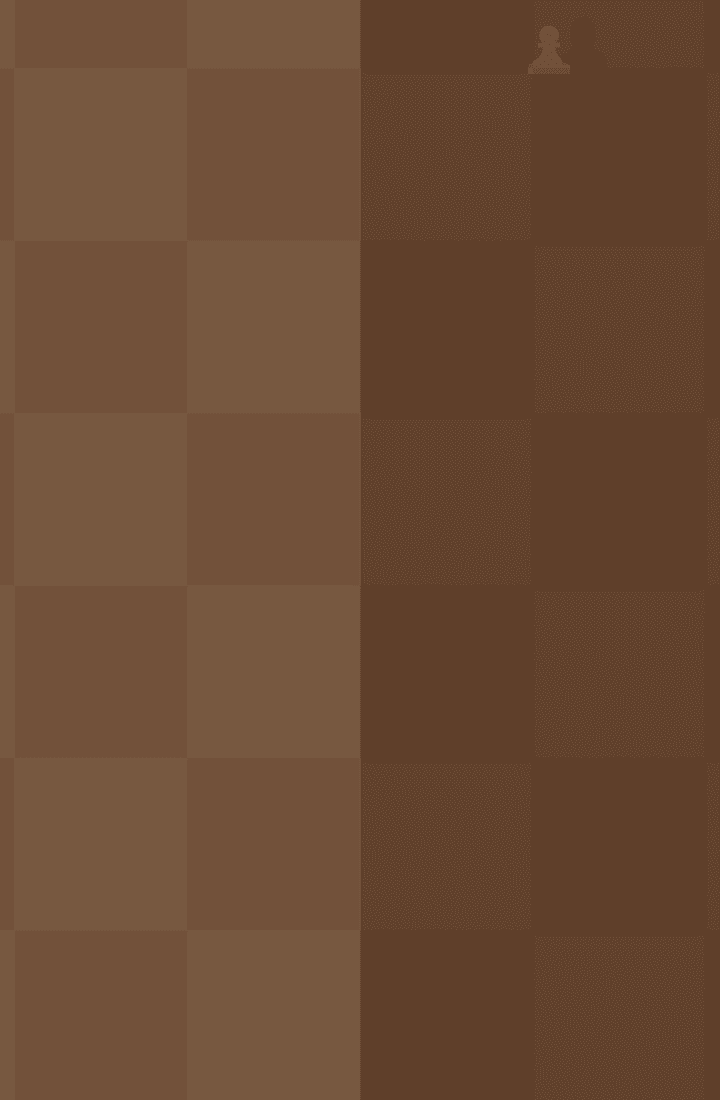
Chess is a strategy game for two. Especially in Europe it is very famous and often played.
Let's start
White always starts the game. When you challenge someone in chess, you are playing White.
Game objective
The game of chess is played between two opponents who move their pieces on a square board called a ‘chessboard’. The player with the light-coloured pieces (White) makes the first move, then the players move alternately, with the player, playing the dark-coloured pieces (Black), making the next move.
A player is said to ‘have the move’ when his opponent’s move has been ‘made’.
The objective of each player is to place the opponent’s king ‘under attack’ in such a way that the opponent has no legal move. The player who achieves this goal is said to have ‘checkmated’ the opponent’s king and to have won the game. Leaving one’s own king under attack, exposing one’s own king to attack and also ’capturing’ the opponent’s king is not allowed. The opponent whose king has been checkmated has lost the game.
If the position is such that neither player can possibly checkmate the opponent’s king, the game is drawn.
The basics
At the beginning of the game White has 16 light-coloured pieces (the ‘white’ pieces); Black has 16 dark-coloured pieces (the ‘black’ pieces). These pieces are as follows:
  |
  |
| 1 king | 1 queen |
  |
  |
| 2 rooks | 2 bishops |
  |
  |
| 2 knights | 8 pawns |
The eight vertical columns of squares, marked with letters, are called ‘files’. The eight horizontal rows of squares are called ‘ranks’ and they are marked with numbers. A straight line of squares of the same colour, running from one edge of the board to an adjacent edge, is called a ‘diagonal’.
The moves of the pieces
To move a piece, tap it first. It will get marked and small dots are showing where you could move it. Tap on one of the dots to actually move the piece.
 If yu can attack a piece, it is highlighted in the corners of its square.
If yu can attack a piece, it is highlighted in the corners of its square.
 It is not permitted to move a piece to a square, occupied by a piece of the same colour. If a piece moves to a square, occupied by an opponent’s piece, the latter is captured and removed from the chessboard as part of the same move. A piece is said to attack an opponent’s piece if the piece could make a capture on that square. A piece is considered to attack a square even if this piece is constrained from moving to that square because it would then leave or place the king of its own colour under attack.
It is not permitted to move a piece to a square, occupied by a piece of the same colour. If a piece moves to a square, occupied by an opponent’s piece, the latter is captured and removed from the chessboard as part of the same move. A piece is said to attack an opponent’s piece if the piece could make a capture on that square. A piece is considered to attack a square even if this piece is constrained from moving to that square because it would then leave or place the king of its own colour under attack.
When your opponent made a move it is highlighted with yellow markers. They mark the start and the end of the move.

The bishop
The bishop may move to any square along a diagonal on which it stands.

The rook
The rook may move to any square along the file or the rank on which it stands.

The queen
The queen may move to any square along the file, the rank or a diagonal on which it stands.

Bishop, rook and queen
When making these moves, the bishop, rook or queen may not move over any intervening pieces.
The knight
The knight may move to one of the squares nearest to that on which it stands but not on the same rank, file or diagonal.

The pawn
There is a difference between moving a pawn and attacking with a pawn.
- a) The pawn may move forward to the square immediately in front of it on the same file, provided that this square is unoccupied, or
- b) on its first move the pawn may move as in a) or alternatively it may advance two squares along the same file, provided that both squares are unoccupied, or
- c) the pawn may move to a square occupied by an opponent’s piece diagonally in front of it on an adjacent file, capturing that piece.
- d) A pawn occupying a square on the same rank as and on an adjacent file to an opponent’s pawn which has just advanced two squares in one move from its original square may capture this opponent’s pawn as though the latter had been moved only one square. This capture is only legal on the move following this advance and is called an ‘en passant’ capture.
- e) When a player, having the move, plays a pawn to the rank furthest from its starting position, he must exchange that pawn as part of the same move for a new queen, rook, bishop or knight of the same colour on the intended square of arrival. This is called the square of ‘promotion’. The player's choice is not restricted to pieces that have been captured previously. This exchange of a pawn for another piece is called promotion, and the effect of the new piece is immediate.
You can choose with the blue buttons what your promotion shall be.


The king
There are two different ways of moving the king:
- a) by moving to an adjoining square
- b) by ‘castling’.
Castling is a move of the king and either rook of the same colour along the player’s first rank, counting as a single move of the king and executed as follows: the king is transferred from its original square two squares towards the rook on its original square, then that rook is transferred to the square the king has just crossed.
- The right to castle has been lost:
- a) if the king has already moved, or
- b) with a rook that has already moved.
- Castling is prevented temporarily:
- c) if the square on which the king stands, or the square which it must cross, or the square which it is to occupy, is attacked by one or more of the opponent's pieces, or
- d) if there is any piece between the king and the rook with which castling is to be effected.

The king is said to be 'in check' if it is attacked by one or more of the opponent's pieces, even if such pieces are constrained from moving to the square occupied by the king because they would then leave or place their own king in check.
A king in check is marked red.
 No piece can be moved that will either expose the king of the same colour to check or leave that king in check.
No piece can be moved that will either expose the king of the same colour to check or leave that king in check.
A move is legal when all the relevant requirements of a) - d) have been fulfilled. A move is illegal when it fails to meet the relevant requirements of a) - d). A position is illegal when it cannot have been reached by any series of legal moves.
Notation table
All moves are noted in the notation table. You can open it anytime by tapping on the avatars in the upper area of the game card. To close it tap on the lower right button.
The table contains the following information for both players:
- The number of the move
- A picture of the moved piece, there is no picture if the piece is a pawn
- Start and end squares of the move
Moves to an empty square are marked with „–“, captures with „×” between the squares - A marker for in check („+”) and checkmate („#“)
- A marker for a promotion of a pawn - the new piece is shown as a picture
- A marker kingside castling („0–0") and queenside castling („0–0–0")
- A marker for capturing en passant („e.p.”)
- The captured piece
Left and right of the table is the difference of are all captured pieces listed.
If both of you captured one pawn, it is not listed. If you captured 2 pawns and your opponent only 1, a single enemy pawn is shown.
End of the game
Checkmate
The game is won by the player who has checkmated his opponent’s king. This immediately ends the game.
Draw
To offer a draw, you must open the notation table before you make your move. There you can tap the draw button, then make your move. Your opponent will be asked to accept the draw before his next move.
- a) The game is drawn when the player to move has no legal move and his king is not in check. The game is said to end in ‘stalemate’. This immediately ends the game.
- b) The game is drawn when a position has arisen in which neither player can checkmate the opponent’s king with any series of legal moves. The game is said to end in a ‘dead position’. This immediately ends the game.
- d) The game is drawn when the exact same position appears for the third time on the board.
- e) The game is drawn when the last 50 moves did not contain any captures or moving a pawn.
Revenge
The player creating the game starts the first time. Afterwards you start the games alternating.


